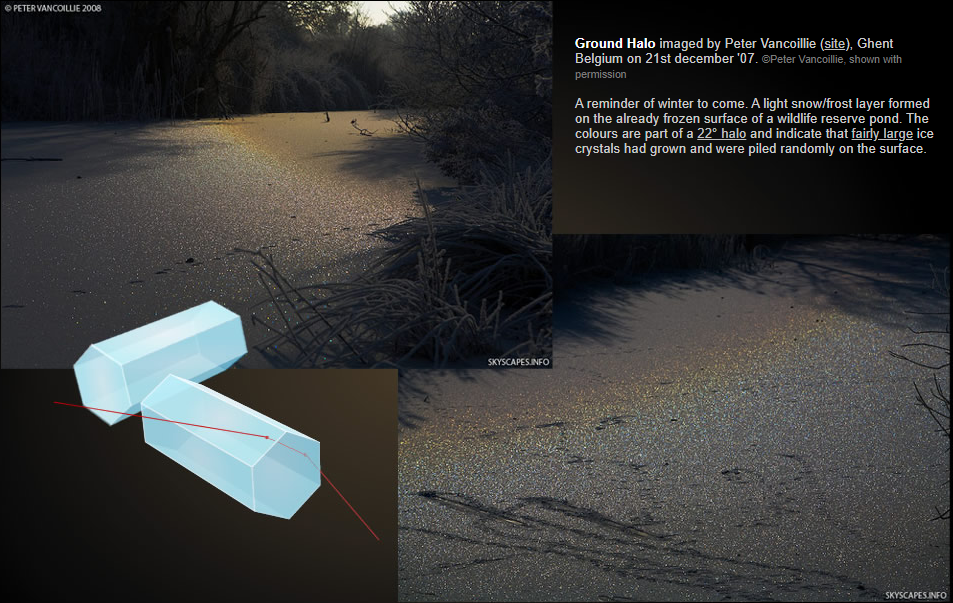Summer Ice
Summer Ice: A Fascinating Phenomenon in Atmospheric Optics
When we think of summer, we usually envision warm weather, sunny skies, and ice-cold beverages to beat the heat. However, there is a lesser-known atmospheric optics phenomenon that occurs during the summer months called "summer ice." While it may seem contradictory to associate ice with the hottest season of the year, summer ice is a captivating occurrence that adds a touch of magic to the atmosphere.
Understanding Summer Ice
Summer ice refers to the formation of ice crystals in the atmosphere during the summer season. These ice crystals can take on various forms and create stunning optical displays in the sky. One of the most notable manifestations of summer ice is the appearance of halos around the sun or moon.
The Science Behind Summer Ice
The formation of summer ice is a result of specific atmospheric conditions. It typically occurs when there is a high concentration of ice nuclei, which are microscopic particles that act as a catalyst for ice crystal formation. These ice nuclei can be dust particles, pollen, or even bacteria. When these particles come into contact with water vapor in the atmosphere, they freeze and form ice crystals.
The Beauty of Summer Ice
One of the most captivating aspects of summer ice is the display of halos that accompany it. Halos are circular or elliptical rings of light that form around the sun or moon. They occur when light is refracted and reflected by ice crystals in the atmosphere. The size and shape of the halo depend on the type and orientation of the ice crystals.
Types of Halos Associated with Summer Ice
There are several types of halos that can be observed during the summer months when summer ice is present. Some of these include:
- 22° Halo: This is one of the most common types of halos associated with summer ice. It appears as a circular ring around the sun or moon, approximately 22 degrees from the light source.
- Sun Dogs: Also known as parhelia, sun dogs are bright spots of light that appear on either side of the sun. They are caused by the refraction of sunlight through ice crystals in the atmosphere.
- Circumzenithal Arc: This halo forms an upside-down rainbow or smile shape in the sky. It is often referred to as an "upside-down rainbow" due to its distinctive appearance.
Capturing the Magic of Summer Ice
Photographers and sky enthusiasts often seize the opportunity to capture the beauty of summer ice through their lenses. These optical phenomena create awe-inspiring images that showcase the intricate patterns and colors formed by the ice crystals. Photographers use various techniques to capture these fleeting moments, including adjusting exposure settings and using polarizing filters to enhance the contrast.
The Importance of Understanding Summer Ice
Studying summer ice and its associated atmospheric optics phenomena is crucial for several reasons:
- Climate Research: By studying the occurrence and characteristics of summer ice, scientists can gain insights into the composition and behavior of the atmosphere. This information is vital for understanding climate patterns and predicting future changes.
- Aviation Safety: Summer ice can pose a risk to aviation, particularly during takeoff and landing. Understanding the conditions that lead to the formation of ice crystals can help pilots and air traffic controllers make informed decisions regarding flight operations.
- Public Engagement: Sharing knowledge about summer ice and its visual displays can foster public interest in atmospheric optics and science as a whole. It encourages people to look up at the sky and appreciate the wonders that occur above us.
In conclusion, summer ice is a captivating phenomenon within atmospheric optics that adds a touch of wonder to the warmest season of the year. The formation of ice crystals in the atmosphere leads to the creation of stunning halos, such as the 22° halo, sun dogs, and circumzenithal arcs. Understanding summer ice not only contributes to scientific research and aviation safety but also encourages a deeper appreciation for the beauty and complexity of our atmosphere. So, the next time you find yourself enjoying a summer day, take a moment to look up at the sky and marvel at the magic of summer ice.

Ground Halo imaged by Peter Vancoillie (site), Ghent Belgium on 21st december '07. ©Peter Vancoillie, shown with permission.
A reminder of winter to come. A light snow/frost layer formed on the already frozen surface of a wildlife reserve pond. The colours are part of a 22° halo and indicate that fairly large ice crystals had grown and were piled randomly on the surface.
Note: this article has been automatically converted from the old site and may not appear as intended. You can find the original article here.
Reference Atmospheric Optics
If you use any of the definitions, information, or data presented on Atmospheric Optics, please copy the link or reference below to properly credit us as the reference source. Thank you!
-
<a href="https://atoptics.co.uk/blog/summer-ice-2/">Summer Ice</a>
-
"Summer Ice". Atmospheric Optics. Accessed on April 28, 2024. https://atoptics.co.uk/blog/summer-ice-2/.
-
"Summer Ice". Atmospheric Optics, https://atoptics.co.uk/blog/summer-ice-2/. Accessed 28 April, 2024
-
Summer Ice. Atmospheric Optics. Retrieved from https://atoptics.co.uk/blog/summer-ice-2/.